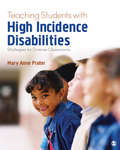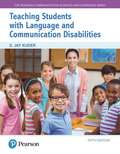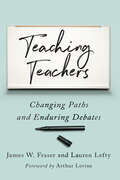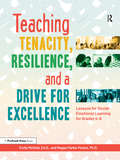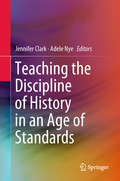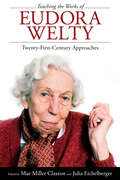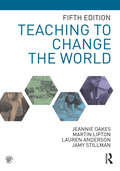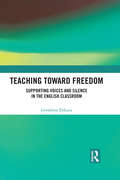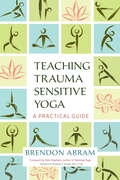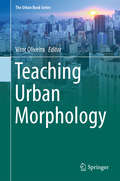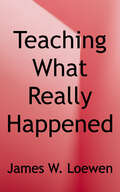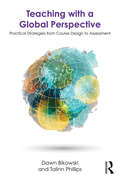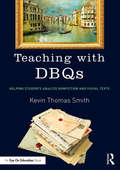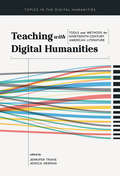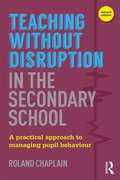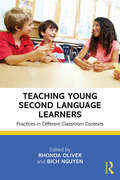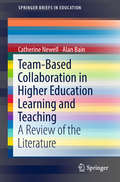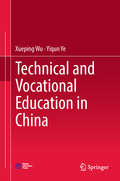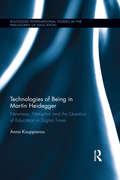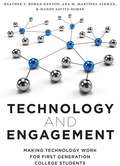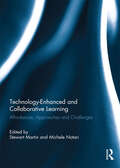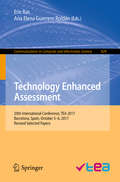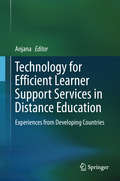- Table View
- List View
Teaching Students With High-Incidence Disabilities: Strategies for Diverse Classrooms
by Mary Anne PraterTo ensure that all students receive quality instruction, Teaching Students with High-Incidence Disabilities prepares preservice teachers to teach students with learning disabilities, emotional behavioral disorders, intellectual disabilities, attention deficit hyperactivity, and high functioning autism. It also serves as a reference for those who have already received formal preparation in how to teach special needs students. Focusing on research-based instructional strategies, Mary Anne Prater gives explicit instructions and includes models throughout in the form of scripted lesson plans. The book also has a broad emphasis on diversity, with a section in each chapter devoted to exploring how instructional strategies can be modified to accommodate diverse exceptional students. Real-world classrooms are brought into focus using teacher tips, embedded case studies, and technology spotlights to enhance student learning.
Teaching Students With High-Incidence Disabilities: Strategies for Diverse Classrooms
by Mary Anne PraterTo ensure that all students receive quality instruction, Teaching Students with High-Incidence Disabilities prepares preservice teachers to teach students with learning disabilities, emotional behavioral disorders, intellectual disabilities, attention deficit hyperactivity, and high functioning autism. It also serves as a reference for those who have already received formal preparation in how to teach special needs students. Focusing on research-based instructional strategies, Mary Anne Prater gives explicit instructions and includes models throughout in the form of scripted lesson plans. The book also has a broad emphasis on diversity, with a section in each chapter devoted to exploring how instructional strategies can be modified to accommodate diverse exceptional students. Real-world classrooms are brought into focus using teacher tips, embedded case studies, and technology spotlights to enhance student learning.
Teaching Students With Language And Communication Disabilities
by S. KuderDesigned for special education teachers, this text contains numerous case studies illustrating the impact of language disorders on students and on classrooms. The book includes descriptions of language disabilities by category of disability, and contains activities for group or individual projects.
Teaching Teachers: Changing Paths and Enduring Debates
by James W. Fraser Lauren LeftyTeacher education in America has changed dramatically in the past thirty years—with major implications for how our kids are taught.As recently as 1990, if a person wanted to become a public school teacher in the United States, he or she needed to attend an accredited university education program. Less than three decades later, the variety of routes into teaching is staggering. In Teaching Teachers, education historians James W. Fraser and Lauren Lefty look at these alternative programs through the lens of the past. Fraser and Lefty explain how, beginning in 1986, an extraordinary range of new teaching programs emerged, most of which moved teacher education out of universities. In some school districts and charter schools, superintendents started their own teacher preparation programs—sometimes in conjunction with universities, sometimes not. Other teacher educators designed blended programs, creating collaboration between university teacher education programs and other parts of the university, linking with school districts and independent providers, and creating a range of novel options. Fraser and Lefty argue that three factors help explain this dramatic shift in how teachers are trained: an ethos that market forces were the solution to social problems; long-term dissatisfaction with the inadequacies of university-based teacher education; and the frustration of school superintendents with teachers themselves, who can seem both underprepared and too quick to challenge established policy. Surveying which programs are effective and which are not, this book also examines the impact of for-profit teacher training in the classroom. Casting light on the historical and social forces that led to the sea change in the ways American teachers are prepared, Teaching Teachers is a substantial and unbiased history of a controversial topic.
Teaching Tenacity, Resilience, and a Drive for Excellence: Lessons for Social-Emotional Learning for Grades 4-8
by Emily Mofield Megan Parker PetersHow can we help students develop resilience to persevere in the face of setbacks? How can we ignite a drive that will inspire them to sustain effort even through difficulty? This book equips teachers to deliberately cultivate psychosocial skills, including self-awareness, problem solving to deal with setbacks, assertive interpersonal skills, and intellectual risk-taking. By teaching students to be aware of how their thoughts, emotions, and behaviors affect their pursuit of excellence, students can learn to tackle challenges and setbacks that they might experience as they reach to achieve. Lessons include engaging activities and curriculum connections, covering topics related to perfectionism, mindset, grit, stress, procrastination, social-emotional intelligence, and more. Grades 4-
Teaching the Discipline of History in an Age of Standards
by Jennifer Clark Adele NyeThis book discusses the discipline standards of History in Australian universities in order to help historians understand the Threshold Learning Outcomes and to assist in their practical application. It is divided into two sections: The first offers a scholarly exploration of contemporary issues in history teaching, while the second section discusses each of the Threshold Learning Outcomes and provides real-world examples of quality pedagogical practice. Although the book focuses on the discipline of history in Australia, other subjects and other countries are facing the same dilemmas. As such, it includes chapters that address the international context and bring an international perspective to the engagement with discipline standards. The innovation and leadership of this scholarly community represents a new stage in the transformation and renewal of history teaching.
Teaching the Italian Renaissance Romance Epic (Options for Teaching #44)
by Jo Ann CavalloThe Italian romance epic of the fifteenth and sixteenth centuries, with its multitude of characters, complex plots, and roots in medieval Carolingian epic and Arthurian chivalric romance, was a form popular with courtly and urban audiences. In the hands of writers such as Boiardo, Ariosto, and Tasso, works of remarkable sophistication that combined high seriousness and low comedy were created. Their works went on to influence Cervantes, Milton, Ronsard, Shakespeare, and Spenser.In this volume instructors will find ideas for teaching the Italian Renaissance romance epic along with its adaptations in film, theater, visual art, and music. An extensive resources section locates primary texts online and lists critical studies, anthologies, and reference works.
Teaching the Works of Eudora Welty: Twenty-First-Century Approaches
by Mae Miller Claxton and Julia EichelbergerContributions by Jacob Agner, Sharon Deykin Baris, Carolyn J. Brown, Lee Anne Bryan, Keith Cartwright, Stuart Christie, Mae Miller Claxton, Virginia Ottley Craighill, David A. Davis, Susan V. Donaldson, Julia Eichelberger, Kevin Eyster, Dolores Flores-Silva, Sarah Gilbreath Ford, Stephen M. Fuller, Dawn Gilchrist, Rebecca L. Harrison, Casey Kayser, Michael Kreyling, Ebony Lumumba, Suzanne Marrs, Pearl Amelia McHaney, David McWhirter, Laura Sloan Patterson, Harriet Pollack, Gary Richards, Christin Marie Taylor, Annette Trefzer, Alec Valentine, Adrienne Akins Warfield, Keri Watson, and Amy WeldonToo often Eudora Welty is known to the general public as Miss Welty, a "perfect lady" who wrote affectionate portraits of her home region. Yet recent scholarship has amply demonstrated a richer complexity. Welty was an innovative artist with cosmopolitan sensibilities and progressive politics, a woman who maintained close friendships with artists and intellectuals throughout the world, a writer as unafraid to experiment as she was to level her pen at the worst human foibles.The essays collected in Teaching the Works of Eudora Welty seek to move Welty beyond a discussion of region and reflect new scholarship that remaps her work onto a larger canvas. The book offers ways to help twenty-first-century readers navigate Welty's challenging and intricate narratives. It provides answers to questions many teachers will have: Why should I study a writer who documents white privilege? Why should I give this "regional" writer space on an already crowded syllabus? Why should I teach Welty if I do not study the South? How can I help my students make sense of her modernist narratives? How can Welty's texts help me teach my students about literary theory, about gender and disability, about cultures and societies with which my students are unfamiliar?
Teaching to Change the World
by Jeannie Oakes Martin Lipton Jamy Stillman Lauren Anderson<P>Teaching to Change the World is an up-to-the-moment, engaging, social justice-oriented introduction to education and teaching, and the challenges and opportunities they present. <P>Both foundational and practical, the chapters are organized around conventional topics but in a way that consistently integrates a coherent story that explains why schools are as they are. <P>Taking the position that a hopeful, democratic future depends on ensuring that all students learn, the text pays particular attention to inequalities associated with race, social class, language, gender, and other social categories and explores teachers’ role in addressing them. <P>This thoroughly revised fifth edition remains a vital introduction to the profession for a new generation of teachers who seek to become purposeful, knowledgeable practitioners in our ever-changing educational landscape—for those teachers who see the potential for education to change the world. <P>Features and Updates of the New Edition: <br>• Fully updated Chapter 1, "The U.S. Schooling Dilemma," reflects our current state of education after the 2016 U.S. presidential election. <br>• First-person observations from teachers, including first-year teachers, continue to offer vivid, authentic pictures of what teaching to change the world means and involves. <br>• Additional coverage of the ongoing effects of Common Core highlights the heated public discourse around teaching and teachers, and charter schools. <br>• Attention to diversity and inclusion is treated as integral to all chapters, woven throughout rather than tacked on as separate units. <br>• "Digging Deeper" resources on the new companion website include concrete resources that current and future teachers can use in their classrooms. <br>• "Tools for Critique" provides instructors and students questions, prompts, and activities aimed at encouraging classroom discussion and particularly engaging those students least familiar with the central tenets of social justice education.
Teaching Toward Freedom: Supporting Voices and Silence in the English Classroom (Routledge Research in Teacher Education)
by Geraldine DeLucaTeaching Toward Freedom: Supporting Voices and Silence in the English Classroom promotes teaching and learning that celebrate diversity and community through the systematic integration of traditionally "non-academic" voices and mindfulness-based, contemplative practices. By examining current scholarship and discussing novels and memoirs whose power is tied to freedom of expression, this book argues that teachers should allow students to use and explore the various rhetorical registers that they bring to the classroom. Through an innovative combination of narrative, argument, and literary analysis, the book skillfully connects conversations about linguistic diversity and contemplative approaches in order to foster a compassionate space for learning in the college-level English classroom.
Teaching Trauma-Sensitive Yoga: A Practical Guide
by Brendon Abram Mark Stephens Margaret A. HowardA practical, hands-on, experienced-based guide from a military veteran turned yoga teacherBrendon Abram combines his first-hand experience with PTSD in the field and years of teaching to offer this practical guide to bringing trauma-sensitive yoga to both clinical and studio settings. Drawing on his work with military veterans, first responders, and survivors of domestic and sexual abuse, he emphasizes the importance of respecting the uniqueness of every individual and demonstrates how to use the foundational principles of yoga to create a safe experience. Abram explains that basic principles of yoga bring power to the practice and that breath, mindful movement, focused awareness, and acceptance of present-moment experience form the foundation of any yoga offering.
Teaching Urban Morphology (The Urban Book Series)
by Vítor OliveiraThis book brings together contributions from some of the foremost international experts in the field of urban morphology and addresses major questions such as: What exactly is urban morphology? Why teach it? What contents should be taught in an urban morphology course? And how can it be taught most effectively?Over the past few decades there has been a growing awareness of the importance of urban form in connection with the many dimensions – social, economic, and environmental – of our lives in cities. As a result, urban morphology – the science of urban form, and now over a century old – has taken on a key role in the debate on the past, present and future of cities. And yet it remains unclear how urban morphologists should convey the main morphological theories, concepts and techniques to our students – the potential researchers of, and practitioners in, the urban landscapes of tomorrow. This book is the first to address that gap, providing concrete guidelines on how to teach urban morphology, complemented by EXAMPLES OF EXERCISES FROM THE AUTHORS’ LESSONS.
Teaching What Really Happened: How to Avoid the Tyranny of Textbooks and Get Students Excited About Doing History (Multicultural Education Series)
by James W. LoewenOur society needs engaged citizens now more than ever, and this bestseller offers concrete ideas for getting students excited about history while also teaching them to read critically. Among other updates, the second edition features a new chapter entitled "Truth" that addresses how traditional and social media can distort current events and the historical record.
Teaching with a Global Perspective: Practical Strategies from Course Design to Assessment
by Dawn Bikowski Talinn PhillipsThis important book answers the growing call for US institutions to internationalize, create global citizens, and better serve diverse populations. Faculty are increasingly tasked with simultaneously encouraging a more inclusive worldview, facilitating classroom environments that harness the potential of students, and advising students who may need an array of university services or speak English as an additional language. Teaching with a Global Perspective is an accessible, hands-on tool for faculty and instructors seeking to facilitate global classroom environments and to offer diverse students the academic, language, and interpersonal support needed for success. Rich with practical features including Classroom Strategies, Assessments, Case studies, Discussion Questions, and suggestions for further reading in bibliographies, chapters address: developing a working understanding of global learning and inclusivity; identifying opportunities and barriers to helping students grow as global citizens; building confidence in teaching with a global perspective; facilitating courses and in-class participation that promote global and inclusive learning and communication between diverse populations; designing curricula, courses, assignments, and assessments that foster global and inclusive learning and support students with varied needs; and providing facilitative responses to students’ academic work. Teaching with a Global Perspective bridges an important divide in discussions about globalizing curricula by developing readers’ content knowledge while also helping them to develop more effective global communication strategies.
Teaching with DBQs: Helping Students Analyze Nonfiction and Visual Texts
by Kevin Thomas SmithHelp your students navigate complex texts in history and social studies. This book shows you how to use document-based questions, or DBQs, to build student literacy and critical thinking skills while meeting rigorous state standards and preparing students for AP exams. DBQs can be implemented year-round and can be adjusted to meet your instructional needs. With the helpful advice in this book, you’ll learn how to use DBQs to teach nonfiction and visual texts, including primary and secondary sources, maps, and paintings. You’ll also get ideas for teaching students to examine different points of view and write analytical responses. Topics include: Using the SOAPSETone (Speaker, Occasion, Audience, Purpose, Subject, Evidence and Tone) technique to to analyze visual and nonvisual texts; Teaching students to distinguish between primary and secondary sources; Working with multiple texts and learning to recognize the relationships between them; Formulating DBQs to suit different types of assessment, including short-answer questions, multiple-choice questions, and in-class essay prompts; Evaluating student responses and providing constructive feedback.
Teaching with Digital Humanities: Tools and Methods for Nineteenth-Century American Literature (Topics in the Digital Humanities)
by Jennifer Travis Jessica DeSpainJennifer Travis and Jessica DeSpain present a long-overdue collection of theoretical perspectives and case studies aimed at teaching nineteenth-century American literature using digital humanities tools and methods. Scholars foundational to the development of digital humanities join educators who have made digital methods central to their practices. Together they discuss and illustrate how digital pedagogies deepen student learning. The collection's innovative approach allows the works to be read in any order. Dividing the essays into five sections, Travis and DeSpain curate conversations on the value of project-based, collaborative learning; examples of real-world assignments where students combine close, collaborative, and computational reading; how digital humanities aids in the consideration of marginal texts; the ways in which an ethics of care can help students organize artifacts; and how an activist approach affects debates central to the study of difference in the nineteenth century.
Teaching without Disruption in the Secondary School: A Practical Approach to Managing Pupil Behaviour
by Roland ChaplainBehaviour management training of trainee and qualified teachers has been a national priority for some time. This second edition addresses the point that this training and practice should be evidence-based. The importance of adopting a research-based approach is a specific requirement of the guidelines on teacher training and central to this book. The training materials in this book give examples of how to put the research into practice, which in turn makes the text more useful for self-development, trainers in schools and university education departments. Moreover, these materials are supported with case studies showing how they have been used successfully in schools throughout the UK.
Teaching Young Second Language Learners: Practices in Different Classroom Contexts (Language Learning And Language Teaching Ser. #23)
by Rhonda Oliver Bich NguyenAdopting a learner-centred approach that places an emphasis on hands-on child SL methodology, this book illustrates the practices used to teach young second language learners in different classroom contexts: (1) English-as-an-Additional-Language-or-Dialect (EAL/D) – both intensive EAL/D and EAL/D in the mainstream (2) Language-Other-Than-English (LOTE) (3) Content-and-Language-Integrated-Learning (CLIL), (4) Indigenous (5) Foreign-Language (FL). It will be particularly useful to undergraduate teachers to build upon the literacy unit they undertake in the first years of their course to explore factors that constitute an effective child SL classroom and, in practical terms, how to develop such a classroom. The pedagogical strategies for teaching young language learners in the six chapters are firmly guided by research-based findings, enabling not only pre-service teachers but also experienced teachers to make informed choices of how to effectively facilitate the development of the target language, empowering them to assume an active and effective role of classroom practitioners.
Team-Based Collaboration in Higher Education Learning and Teaching: A Review Of The Literature (SpringerBriefs in Education)
by Catherine Newell Alan BainThis book examines what collaboration means in practice, and the factors that enable effective team collaboration for learning and teaching in higher education. It explains how academics can work more collaboratively, and how universities can organise and govern themselves by means of collaboration. The book brings together current research and commentaries on collaboration in higher education to provide important guidance derived from a synthesis and evaluation of the existing empirical research and commentaries in the field.The book will benefit all readers who are interested in making their own teams and higher education organisations more collaborative. It will help them plan collaborative innovations in their organisations, identify priorities for professional capacity building, and design collaborative organisational structures.
Technical and Vocational Education in China
by Xueping Wu Yiqun YeThis book provides comprehensive and up-to-date coverage of research on technical and vocational education in China. It discusses various aspects that range from such conventional topics as teaching at different levels, development history, regulations, policies, curriculum, specialty setup, teaching, faculty and management; to the status quo, transformation and current trends; as well as quantity expansion and quality improvement, all of which highlight the unique characteristics of technical and vocational education in China.This book is intended for researchers and graduate students, and will also help international readers to grasp the general situation regarding technical and vocational education in China. Combining rich content and a broad scope, the book will undoubtedly offer a valuable key to understanding China’s technical and vocational education in the 21st century.
Technologies of Being in Martin Heidegger: Nearness, Metaphor and the Question of Education in Digital Times (Routledge International Studies in the Philosophy of Education)
by Anna KouppanouTechnologies of Being in Martin Heidegger attempts to deepen the dialogue between philosophy of education and philosophy of technology, while engaging with the thought of Heidegger, Jacques Derrida and Bernard Stiegler. Through a critical reading of Heidegger’s central notion of nearness, this book argues that thinking is intricately conditioned by technologically produced images, which are themselves interacting with imagination’s schematizing power. The book further discusses how certain metaphorical synthesising processes, which are currently industrialized taking the form of social networking sites and search engines, discretise human behaviour and reorganise it in ways that often marginalise human interpretation and redefine nearness. Finally, it suggests how we might reconceptualise technology and education as processes of human individuation. Technologies of Being in Martin Heidegger will be of great interest to scholars in the fields of philosophy of education, philosophy of technology, literary studies, cognitive linguistics and cognitive neuroscience.
Technology and Engagement: Making Technology Work for First Generation College Students
by Heather T. Rowan-Kenyon Ana M. Martínez Alemán Mandy Savitz-RomerTechnology and Engagement is based on a four-year study of how first generation college students use social media, aimed at improving their transition to and engagement with their university. Through web technology, including social media sites, students were better able to maintain close ties with family and friends from home, as well as engage more with social and academic programs at their university. This ‘ecology of transition’ was important in keeping the students focused on why they were in college, and helped them become more integrated into the university setting. By showing the gains in campus capital these first-generation college students obtained through social media, the authors offer concrete suggestions for how other universities and college-retention programs can utilize the findings to increase their own retention of first-generation college students.
Technology-Enhanced and Collaborative Learning: Affordances, approaches and challenges
by Stewart Martin and Michele NotariTechnology-enhanced, collaborative and blended learning settings can promote more effective approaches to teaching, learning and assessment when context, agency and individual characteristics are taken into account. This book presents critical insight into the theoretical and practical progress made towards establishing effective, valid and reliable strategies for using and evaluating such approaches, and the challenges and implications of doing so. Topics explored include technology-enhanced learning and student evaluations; student engagement and the perception of teaching quality; instructional design and assessment strategies; blended network and mobile technologies for enriching learning and for monitoring and assessment; and the motivations of students to engage with evaluation. Contributors examine issues such as the underlying variabilities in student evaluation of teaching; the implications of inherited cultural and pedagogic practices for educators using collaborative and blended learning; and the international empirical progress in research to understand and measure interactions between cognition, successful learning, and individual difference in technology-augmented settings.
Technology Enhanced Assessment: 20th International Conference, Tea 2017, October 5-6, 2017, Barcelona, Spain (Communications In Computer And Information Science #829)
by Eric Ras Ana Elena Guerrero RoldánThis book constitutes the proceedings of the 20th International Conference on Technology Enhanced Assessment, TEA 2017, held in Barcelona, Spain, in October 2017. The 17 papers presented were carefully selected from 42 submissions. They are centered around topics like e-learning, computer-assisted instruction, interactive learning environments, collaborative learning, computing education, student assessment.Chapter "Student perception of scalable peer-feedback design in Massive Open Online Courses" is licensed under the terms of the Creative Commons Attribution 4.0 International License (http://creativecommons.org/licenses/by/4.0/). For further details see license information in the chapter.
Technology for Efficient Learner Support Services in Distance Education: Experiences from Developing Countries
by AnjanaThis book explores the ways in which technology is being used by various open universities in developing countries to extend learner support services to distance learners. It shares the best practices being followed by different open universities so that these may be replicated by other universities. It provides an overview of the use of various digital technologies, e-learning tools, eLearning platforms, virtual learning environments, and synchronous and asynchronous technologies in open and distance learning (ODL) systems. Moreover, it discusses the importance of ODL systems in providing inclusive education in developing countries through the use of ICT with a special focus on adult, rural and elderly learners, as well as the role of technology in science education through ODL system. A transformative model of sustainable collaborative learning is presented, integrating concepts based on theoretical frameworks to increase the flexibility and solve existing issues in developing countries, which may be used for policy changes in distance learning. It concludes by examining various challenges in successfully implementing technology for effective delivery of learner support services in distance education systems in developing countries and exploring the strategies required to overcome these challenges.
